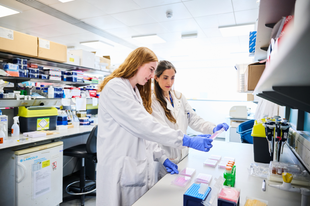Ovarian cancer research breakthroughs: How progress is being made
The research breakthroughs that got us here and the need for more.

Researchers at the Ovarian Cancer Action Research Centre in London.
Over the years, remarkable advancements have shaped the fight against ovarian cancer and we’re making progress. More women are surviving than ever before.
But we still need more of these incredible breakthroughs. Thousands of women in the UK still die every year from ovarian cancer.
With your support, the impact of research will continue snowballing, bringing new treatments ever closer. We will find new ways to prevent, diagnose, and treat ovarian cancer until no one dies of ovarian cancer.
Explore our timeline of breakthroughs to see how far we’ve come and how research continues to transform lives.
1800s | First discoveries
1809 | The first diagnosis of ovarian cancer
The first known case of ovarian cancer was recorded.
1872 | The first surgery for ovarian cancer
Sir Spencer Wells, a surgeon for Queen Victoria, performed the first operation to remove ovarian cancer. He also discovered that ovarian cancer starts in the cells on the surface of the ovary.
1898 | Discovery of radium and polonium
Marie and Pierre Curie discovered radium and polonium—two radioactive elements. This led to the use of radiation to treat cancer within a few years.
1900s–1950s | Early treatments for ovarian cancer
During this time, ovarian cancer was treated with surgery and radiotherapy (using radiation to destroy cancer cells).
1950s | The first chemotherapy is created
Chemotherapy, which uses drugs to kill cancer cells, was developed after discoveries made during World War II.
1953 | Discovery of DNA structure
Scientists James Watson, Francis Crick, and Rosalind Franklin revealed the structure of DNA, the instructions inside our cells that make us who we are. This discovery paved the way for understanding genetic links to cancer.
1956 | Chemotherapy for ovarian cancer
Patients with ovarian cancer were treated with a chemotherapy drug called melphalan for the first time.
1950s–1970s | Combined treatments
During this period, ovarian cancer treatment included surgery and chemotherapy with melphalan.
1976 | A new chemotherapy drug is introduced
A drug called cisplatin replaced melphalan because it was more effective at treating ovarian cancer.
In the 1970s, only 1 in 5 women (18%) diagnosed with ovarian cancer lived for 10 years or more.
1980-2000 | The power of collaboration
1987 | Experts gather to share knowledge
The first Helene Harris Memorial Trust Forum brought together experts from around the world to share research and speed up discoveries for ovarian cancer treatment.

The Helene Harris Memorial Trust
1994 | The discovery of the BRCA1 gene
Scientists discovered the BRCA1 gene, which helps prevent cancer. Inherited changes in this gene can increase the risk of ovarian and breast cancer.
1995 | The discovery of the BRCA2 gene
The BRCA2 gene was found, and like BRCA1, inherited mutations in this gene increase the risk of ovarian and breast cancer.
1996 | Combination chemotherapy
A combination of cisplatin and another drug called taxol was introduced. This combination is still an important part of ovarian cancer treatment today.
1995–2003 | Development of PARP inhibitors
Scientists in London used the BRCA gene discoveries to create *PARP inhibitors. These are drugs that stop cancer cells from repairing themselves, making them easier to destroy.
*PARP inhibitors are a new class of targeted cancer drug that is becoming more common in ovarian cancer treatment.
They can prevent the spread of cancer by stopping a protein called PARP from performing its usual job of helping damaged cells repair themselves. PARP inhibiters can stop (‘inhibit’) this repair process from happening in damaged ovarian cancer cells, which causes the cancer cells to weaken and die.
2000s | Momentum in survival rates
2005 | Ovarian Cancer Action is founded
Helene Harris’ daughter Allyson Kaye founded Ovarian Cancer Action to raise awareness of ovarian cancer symptoms and support research.
2006 | Major milestones for Ovarian Cancer Action
- The Ovarian Cancer Action Research Centre, Europe’s first dedicated ovarian cancer research centre, was established.
- The first-ever Ovarian Cancer Awareness Month was launched.
- Campaigning successfully led to the UK Department of Health recognising the four main symptoms of ovarian cancer.
2013 | BRCA testing begins for patients
Women with ovarian cancer started being tested for BRCA gene mutations. If a mutation is found, family members can also be tested and take steps to reduce their cancer risk.
2015 | PARP inhibitors become available
PARP inhibitors became available in the UK for women with advanced ovarian cancer and a BRCA gene mutation. It took almost 20 years from initial research and clinical trials to becoming approved for use on the NHS.
By 2017, 1 in 3 women (35%) diagnosed with ovarian cancer lived for 10 years or more. That’s doubled since the 1970’s.
2018 | New discoveries about ovarian cancer
The Ovarian Cancer Action funded BriTROC study found that ovarian cancer can be divided into seven subgroups. This discovery is helping researchers create more personalised treatments.
2015–2020 | Wider availability of PARP inhibitors
PARP inhibitors became available for more women with ovarian cancer, regardless of whether they have BRCA mutations.
2019 | Survival rate differences across the UK
Ovarian Cancer Action worked with the NHS to highlight survival rate differences for ovarian cancer patients across the UK.

Improve UK Patient Advisory Group
2021 | A new targeted treatment
Bevacizumab, a treatment designed to block cancer growth, was approved to be used alongside other ovarian cancer treatments.
2024 | Work begins on a preventative vaccine
Research started at the University of Oxford to create the first vaccine to prevent ovarian cancer.
Looking forward
Improvements in survival are thanks to advances in surgery, better awareness of symptoms and much-needed research into the disease and the treatment available.
Since 2005, Ovarian Cancer Action have been dedicated to saving lives.
With you’re your support we’re paving the way for a brighter future for women everywhere until no one dies of ovarian cancer.